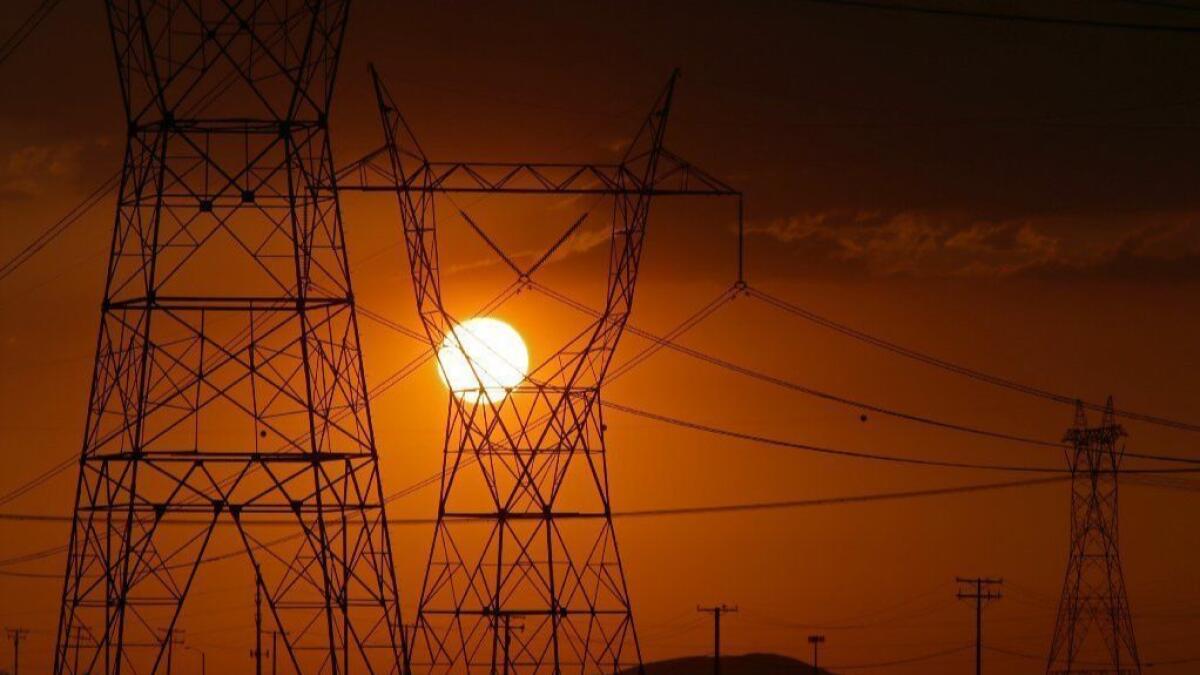Southern Californiaâs heat wave puts the power grid under pressure

Summerâs first heat wave has Southern California utility officials and managers of the stateâs electric grid working to make sure the power system doesnât wilt.
A high-pressure system sent temperatures soaring Friday, and heat records were expected to fall in several spots, including downtown Los Angeles, Woodland Hills and Long Beach, according to the National Weather Service. Significantly cooler temperatures arenât expected to return until the middle of next week.
Utility representatives said adequate electricity supplies have been secured in anticipation of the heat wave and the California Independent System Operator hasnât issued a flex alert â a call for consumers to voluntarily conserve electricity when there is a predicted shortage of energy supply.
But Cal-ISO on Thursday did issue a Restricted Maintenance Operations notice, which orders delays on any planned maintenance of power plant and transmission facilities to make sure all available resources remain so in case they are needed.
âWe have no major transmission or generation outages at this time,â said Steven Greenlee, senior public information officer for Cal-ISO. âBut wildfires are always our concern. That can change things in just a matter of minutes.â
Cal-ISO oversees the operation of about 80% of the stateâs electric power system and runs electricity markets.
Southern California Edison, Los Angeles Department of Water and Power and San Diego Gas & Electric Co. have lined up extra repair crews in case the roasting temperatures cause power outages.
âOur crews are ready to respond to incidents that may occur due to this record heat wave,â said Tony Edeson, Edisonâs grid operations director.
Over the weekend, the DWP is expecting daily peak power usage that is higher than during the average summer day, Chief Operating Officer Martin Adams said, but the municipal utility isnât expecting to break the record 6,502-megawatt peak hit last August.
The average daily peak consumption during the last three summers was 4,350 megawatts, according to the DWP.
As a precautionary measure, SDG&E has canceled scheduled maintenance work in fire-prone areas and asked customers to cut back on energy use.
âWeâve secured enough resources and weâre fully prepared to meet the system demand ... but itâs always a good idea, particularly when these hot weather events come, that everyone help conserve energy where they can,â SDG&E spokesman Joe Britton said.
Utilities are advising customers to be conservative with air conditioning use during the day, reduce power in the afternoon and use washers, dryers and other energy-intensive devices early in the morning and later at night to avoid taxing power-delivery equipment.
âDoing certain things later at night is a lot less inconvenient than a power outage,â Adams said.
Among some of the things customers can do to reduce energy consumption, Britton said, include:
- Instead of air conditioning, use ceiling fans or portable fans;
- Pre-cool your home by running the AC in the morning and turning it off before leaving for work;
- Close drapes and blinds to keep the sun from warming up rooms;
- Run appliances and swimming pool pumps after 9 p.m.
SDG&E has declared Friday a âReduce Your Useâ day, in which customers on the Reduce Your Use Rewards program can receive a credit on their monthly bills by cutting back on energy use from 11 a.m. to 6 p.m. Friday. About 80,000 SDG&E customers have signed up for the plan, Britton said.
With low humidity and dry conditions expected to persist, SDG&E has put its heli-tanker, the Erickson Aircrane, on standby. The aircrane holds as much as 2,650 gallons of water or fire suppressant â the equivalent of five fire engines.
The summer outlook
Cal-ISO issued four flex alerts in 2017, with two coming in late June. The system operator has yet to issue a flex alert this year but Greenlee cautioned that does not necessarily mean the summer of 2018 is shaping up to be more manageable than the summer of 2017.
âItâs too early to tell,â Greenlee said. âWe got through June without the heat waves. We were pleased to see that but weâve got a long way to go.⌠Our biggest worry is in late summer and August and September.â
In May, Cal-ISO released its summer assessment and predicted âan extremely low probabilityâ the system operator will be forced to initiate rotating power outages.
But at the same time, it anticipated capacity would be tight in high-load periods this summer and found a 50% probability of declaring a Stage 2 emergency for at least one hour this summer.
A Stage 2 emergency means demand is outpacing supply, forcing Cal-ISO to dip into its electricity reserves.
Peak demand this summer is expected to be about the same as last year.
Cal-ISO projects 51,947 megawatts of generation will be available to serve demand this summer. The peak demand this summer is anticipated to be 46,625 megawatts under normal conditions. Last yearâs peak load was 50,116 megawatts, recorded Sept. 1.
However, by late summer hydroelectric production is expected to be down by about 1,300 megawatts compared with 2017. The winter of 2016-17 was especially wet in California but the California Department of Water Resources on April 2 of this year reported the water content of the snowpack was just 51% of average.
The summer assessment expects electricity supplies to be adequate during daytime hours, largely because of the high production of solar power across the state. However, solar production falls off when the sun goes down, and energy users come home from work, turn on their air conditioners and use appliances that suck up a lot of power, such as washers and dryers.
âHydroelectric production is a very flexible resource,â Greenlee said. âIt is valuable to us as grid operators because, especially in the late afternoons, we can call upon that to follow demand that may be changing quickly.â
The system has added 692 megawatts of generation since last year â the vast majority from renewable sources, including 60% from solar.
But natural gas-powered generation has dropped by about 837 megawatts since last summer due to plant retirements.
That loss may be somewhat offset by a recommendation by the Energy Division at the California Public Utilities Commission to increase the natural gas storage volume at the Aliso Canyon Storage Facility in Los Angeles County.
The Energy Division calls for raising storage volume at Aliso Canyon to 34 billion cubic feet of gas from 24.6 billion cubic feet at the site.
One billion cubic feet is enough to fuel about 5 million homes in the U.S. for one day.
A massive leak was discovered at Aliso Canyon in October 2015 but not permanently contained until February 2016, forcing the evacuation of more than 8,000 households in the Porter Ranch neighborhood.
All told, about 100,000 metric tons of methane were emitted. According to a UC Davis study, the total greenhouse gas pollution equaled the emissions of a half-million cars driven for a year.
More to Read
Inside the business of entertainment
The Wide Shot brings you news, analysis and insights on everything from streaming wars to production â and what it all means for the future.
You may occasionally receive promotional content from the Los Angeles Times.










